Subscribe now to get notified about IU Jharkhand journal updates!
Shift in Consumer Satisfaction & Consumer Buying Behaviour in Digital Age
Abstract :
Consumer Satisfaction is the product’s performance according to buyer’s expectations. Consumer behaviour is how consumers think& take buying decision , how the consumer makes decision about spending his/her limited resources, such as time, effort and money for purchasing. There are numerous variables which controls the Customer satisfaction as well as buying Behaviour in current digital Age.
With continuous Technological Advancement Consumer Behaviour is getting changed rapidly along with continuous change in the Consumer satisfaction level, Consumer are now not only "Physical Consumer" they are E- Consumer with successful diffusion of Online Shopping Online Consumer Behaviour is the new usher in the Field of Marketing. Consumer is now Digital Consumer & people are more influenced to associate digitally, Consumer behaviour is having a linkage of Brand perception & for online shopping Brand should be trustworthy. With rapid change in Technology Customer Satisfaction Is also changing its pace and dimension, various new variables are added every day.
To understand the Online Consumer behaviour & Consumer satisfaction, various models &frameworks explains variousvariables, As Online Consumer behaviour is directly linked with Online Shopping which ultimately linked with rapid Technological advancement variables are also fastchanging. The key of this review is to understand the relevance of the existing Model & Framework which best fit in this.
Keywords :
Consumer behaviour. consumer attitudes. consumer perceptions. consumer culture. Online shopping, online consumer behaviour model, technology, e-commerceIntroduction
Online shopping is the easy solution for busy life in today’s world. In the past decade, there had been a massive change in the way of customer’s shopping. Despite consumers’ continuation to buy from a physical store, the users or buyers feel very convenient to online shopping. Online shopping saves crucial time for modern people because they get so busy that they cannot or unwilling to spend much time shopping.In the twenty-first century, trade and commerce have been so diversified that multichannel has taken place and online shopping has increased significantly throughout the world (Johnson, Gustafsson, Andreassen, Lervik, & Cha, 2001). Globally, e-commerce constituted about 2.29 trillion dollar market (John, 2018) and expected to reach 4 trillion dollar by 2020 (eMarketer, 2016) due to the double-digit worldwide growth in sales (15%) and order (13%) (eMarketer, 2018)in all sorts of e-commerce such as business-to-business (B2B), business-to-consumer (B2C) (Zuroni& Goh, 2012).
Asia Pacific region is leading the growth of online shopping as compared to the mature market such as the US, UK, Japan and European Countries. The Asia Pacific recorded massive growth, especially in China. In 2016, Asia Pacific region made about $1 trillion in online sales and majority came from China constituting about $899 billion (eMarketer, 2016). With more and more con- sumers become increasingly familiar with the Internet and its benefit, online shopping is becoming popular and getting preference among a group of consumers seeking better value proposition regarding information, convenience, cost, choice. Like other young Asian citizens, Unlike a physical store, all the goods in online stores described through text, with photos, and with multimedia files. Many online stores will provide links for much extra information about their product. On the other hand, some online consumers are an adventurous explorer, fun seeker, shopping lover, and some are technology muddler, hate waiting for the product to ship. Consequently, online consumer behavior (user action during searching, buying, using products) became a contemporary research area for an increasing number of researchers to understand this unique nature of online shopping. The primary goal of a business is to offer product and services that best serve their consumer needs. A business which fulfills the customer needs with satisfaction very well is more successful than its competitors as satisfied buyers tend to make a repetitive purchase. the purpose of this study is to understand the consumer behaviour towards online shopping, their liking, disliking, and satisfaction level.
Literature Review-
Customer Satisfaction-Theoreticalbackground
The Dissonance Theory –The Dissonance Theory is a social psychology theory proposed by Leon Festinger in the 1950s. It posits that when people experience a psychological discomfort or dissonance due to inconsistent beliefs, attitudes, or behaviors, they will try to reduce this dissonance by changing one or more of these elements.
According to the theory, dissonance arises when a person holds two or more conflicting beliefs, attitudes, or behaviours that are inconsistent with each other. This dissonance creates a psychological tension that the person seeks to resolve. To reduce dissonance, individuals may take different actions, such as:
1)Changing their beliefs or attitudes to align with their behaviour
2)Changing their behaviour to align with their beliefs or attitudes
3)Adding new beliefs or attitudes that support their behaviour
The Dissonance Theory suggests that a person who expected a high-value product and received a low-value product would recognize the disparity and experience a cognitive dissonance (Cardozzo, 1965).That is, the disconfirmed expectations create a state of dissonance or a psychological discomfort (Yi, 1990).According to this theory, the existence of dissonance produces pressures for its reduction, which could be achieved by adjusting the perceived disparity. This theory holds that "post exposure ratings are primarily a function of the expectation level because the task of recognizing disconfirmation is believed to be psychologically uncomfortable.Thus consumers are posited to perceptually distort expectation-discrepant performance so as to coincide with their prior expectation level" (Oliver, 1977, p. 480).
Criticism-Oliver (1977), for example, claims that "generally, it is acknowledged that satisfaction derives from a comparison between one's expectation of X and the performance of the product. Therefore, one's post-decision mood level is influenced by the size and direction of this difference. X simply serves as the standard for comparison. Additionally, customers are not particularly under pressure to fix the X-Y discrepancy. In fact, it is believed that acknowledging dissonance leads to feelings of contentment or dissatisfaction.
Limitation-The dissonance theory falls short of providing a comprehensive explanation for consumer happiness, but it does help us realise that expectations are dynamic and can vary during a consumption experience. A new set of expectations might be established as a result of experiences during the holiday, and the significance given to pre-holiday expectations might vary during the holiday.
The Contrast Theory-
The Contrast Theory is a social psychology theory that explains how people perceive and evaluate stimuli in relation to their surrounding context. It proposes that people tend to evaluate a particular stimulus based on the contrast it creates with the stimuli that precede or follow it.
The Contrast Theory suggests that people do not evaluate a stimulus based solely on its intrinsic qualities but rather by comparing it to other stimuli that they have encountered before or after it. This comparison process can lead to a contrast effect, where the perceived value of a stimulus is influenced by the stimuli that surround it.
The Contrast Theory contends that the Dissonance Theory is incorrect. This theory contends that when a consumer's expectations for a product are not met, the contrast between anticipation and result will lead the consumer to exaggerate the discrepancy (Yi, 1990). According to the contrast hypothesis, a consumer who obtains a product that is less valuable than anticipated will emphasise the discrepancy between the actual product and what was anticipated (Cardozzo, 1965). According to this notion, products that perform below expectations will be given lower ratings than they actually deserve (Oliver &DeSarbo, 1988). The Contrast Theory, in other words, would presumptively presume that "outcomes deviating from expectations will cause the subject to favourably or unfavourably react to the disconfirmation experience in that a negative disconfirmation is believed.
"Criticism-Poor performance would be worse than just poor if the Contrast Theory were applied to a consuming environment, and good performance would be better than a grade of good would imply (Oliver, 1997). According to the dissonance theory, the opposite effects happen, and perceived performance is dragged to the initial expectation level, whether it is less than or more favourable than the consumer's expectations. It's critical to remember that these theories have been put to use and tested in controlled, situation-specific, and individually oriented laboratory settings.
Limitation-With a pen (Cardozzo, 1965), a reel-type tape recorder (Olshavsky& Miller, 1972), a ballpoint pen (Anderson, 1973), and a coffee brand (Olson & Dover, 1975), researchers looked at how well these theories predicted customer satisfaction. Therefore, it is intriguing to see whether or not the hypotheses supported by these theories may be accepted or rejected when used in a field survey. Gizli, Tourist Satisfaction and Complaining Behaviour: Measurement and Management Issues in the Tourism and Hospitality Industry, Nova Science Publishers, New York, 2008 research paper on tourism and hospitality services (Oh & Parks, 1997). For example, it is unclear whether all purchases of travel and hospitality services lead to dissonance.
The Expectancy Disconfirmation Paradigm
Oliver (1977; 1980) presented the Expectancy-Disconfirmation Paradigm (EDP) as the most promising theoretical framework for the assessment of customer happiness, drawing on the flaws of the aforementioned early theories of consumer satisfaction. According to the paradigm, consumers make purchases of goods and services with anticipation of how they will perform. The degree of expectation then serves as a benchmark for evaluating the product. In other words, when the product or service has been used, results are compared against predictions. If the result is as expected, confirmation takes place. Disconfirmation happens when expectations and results don't match up.
When expectations and perceptions differ positively or negatively, a consumer is either satisfied or unsatisfied. While there is a confirmation between expectations and performance when service performance is as expected, there is a positive disconfirmation between expectations and perceptions when service performance is better than what the customer initially anticipated. In contrast, there is a negative disconfirmation between expectations and perceptions when service delivery is below what the customer anticipated, which results in unhappiness.

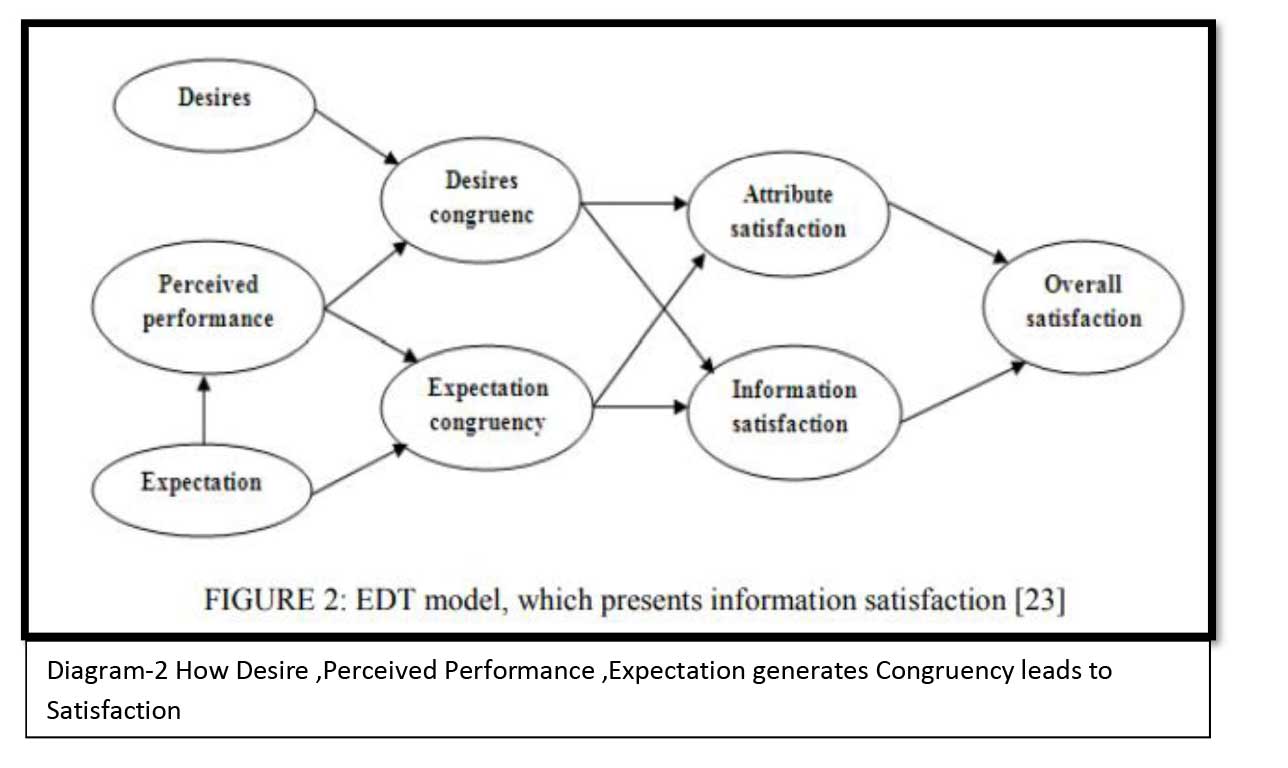
The Comparison Level Theory
The expectation-disconfirmation paradigm has drawn criticism from a number of authors since it assumes that manufacturers', companies', or other unidentified sources' predictive expectations are the main factors in determining customer happiness (Yi, 1990). La Tour and Peat (1979), for example, claimed that the EDP ignores other sources of expectancies, such as the consumer's prior experiences and other consumers' experiences with comparable conceptions.
The Comparison Level Theory (Thibaut & Kelley, 1959) was modified in their proposal. The Comparison Level Theory contends that there are multiple fundamental determinants of comparison level for a product: (1) consumers' prior experiences with comparable products; (2) situationally produced expectations (those created through advertising and promotional efforts); and (3) the experience of other consumers who serve as rudimentary benchmarks. This differs from the expectation-disconfirmation paradigm, which uses predictive or situationally produced expectations as the comparison standard.
Applying the Comparison Level Theory to the confirmation/disconfirmation process, LaTour & Peat discovered that consumers' satisfaction judgements can be compared to experience-based standards or norms as a starting point. They discovered that whereas expectations based on earlier experiences were the main determinant of customer satisfaction, situationally induced expectations had a minimal impact on it. This research implies that when consumers have personal experience and pertinent information about the experiences of other consumers, they may assign less weight to information offered by manufacturers (Yi, 1990).
The comparison level theory contends that consumers may bring a variety of distinct comparison standards into the consumption experience, in contrast to the expectation/confirmation paradigm. Before making a purchase, consumers may be more likely to base their decisions on predictive expectations based on external communication (advertising), whereas different standards (such as prior experience and the experiences of other consumers suggested by LaTour and Peat's model) may become more probable after the sale. However, there is insufficient knowledge about the norms that consumers bring to the consumption experience and how they are validated and disproven
The Value Percept Theory
Westbrook and Reilly (1983) make a similar case to LaTour and Peat that the expectation-disconfirmation paradigm may not be the best model to explain customer satisfaction because it is more likely that comparative standards other than expectations will determine whether a customer is satisfied or dissatisfied. As an alternative to the expectation-disconfirmation paradigm, they put out Locke's value-percept disparity theory from 1967. Westbrook and Reilly make the case that what is expected from a product may or may not correspond to what is wanted or valued in a product, criticising the predictive expectations used as a comparison standard in the conventional confirmation paradigm. In contrast, what is valued may or may not match what is anticipated. As a result, it has been suggested that values are a superior standard toThe value-percept theory postulates that satisfaction is an emotional reaction brought on by a cognitive evaluation process in which one compares their perceptions of an offer to their values, needs, wants, or desires (Westbrook & Reilly, 1983). A rising gap between one's perceptions and one's values (value-perception) denotes an increasing level of unhappiness, much as in the Expectancy/Disconfirmation paradigm.
In their research, Westbrook and Reilly contrasted the value-perception disparity model with the expectation-confirmation model. The degree to which the product offers the features and performance qualities required or sought was used to establish the value-disparity. A single differential scale with the anchors "provides far less than my needs" and "provides exactly what I need" was used to evaluate the gap. They claim that values are in conflict with their hypothesis.
Limitations-
Researchers have not backed the Value-Percept theory as strongly as they have the EDP when it comes to determining customer happiness with hospitality and tourism services. This theory contends that satisfaction results from the fulfilment of consumer desires, values, or needs rather than their expectations.
The Importance- Performance Model
Customers' views of performance and the value of that attribute are thought to be related to their level of satisfaction. According to Barsky (1992), overall satisfaction or dissatisfaction with a product or service is determined by the significance of particular characteristics and the extent to which that product provides those characteristics. This idea is based on the expectancy value model, created by Fishbein and Ajzen (1975), in which attribute importance and beliefs play a key role. According to this paradigm, people will typically hold a belief regarding a characteristic, but each attribute may also be given significant weighting in relation to other attributes. This suggests that the degree to which customers are satisfied is correlated with the intensity of their belief in the significance of a characteristic multiplied by the degree to which the attribute meets their expectations (Barsky, 1992).
Researchers in marketing have used importance as a weighting parameter for another variable being studied in the same decision context (Barksy, 1992; Barsky and Labagh, 1992; Carman, 1990; Cronin & Taylor, 1992; Kivela, 1998; Teas, 1993) or as a replacement variable for consumer expectations (Martilla& James, 1977). Customers expect consistently high levels of service, and their expectations can be manipulated externally (Brown, Churchill, and Peter, 1993). In contrast, the importance given to product or service attributes is based on ingrained cultural norms and personal values (Barsky, 1992).
According to the original importance-performance study, put forth by Martilla and James in 1977, consumer perceptions of performance and the attribute's importance influence satisfaction. This technique can provide useful information (Hemmasi et al., 1995). An importance-performance analysis can map the importance and performance components. It does not require any computation, including subtraction. According to Hemmasi et al. (1995), the important performance model has been determined to be conceptually sound and a potent tool for pinpointing service areas in need of strategic corrective action. Since performance analysis may pinpoint the areas where scarce resources should be directed, it appears to offer a clear course of action. As a result, professionals without advanced computer understanding can use
Performance mapping is important. Performance-important grid analysis used to be seen as an effective management tool, but it has recently fallen out of favour as more quantitative methods have become accessible through computerization (Duke & Persia, 1995). In order to establish a new weighted variable, it is becoming common practise to multiply the importance score for an attribute by the evaluative score assigned to the same attribute.
The Attribution Theory
Research of the Attribution Theory is primarily developed from the Weiner, Frieze and Kukla’s (1971) work. It is important to note that the Attribution theory has been mostly used in dissatisfaction/ complaining behavior models than in satisfaction models per se. According to this model, consumers are regarded as rational processors of information who seek out reasons to explain why a purchase outcome, for example dissatisfaction, has occurred (Folkes, 1984). This model argues that when the delivery of a service does not match customers’ prior expectations or other standards, customers engage in an attributional process in order to make sense of what has occurred (Bitner, 1990). More specifically, this The model presupposes that customers typically ascribe product successes or failures using a three-dimensional schema and that they prefer to hunt for causes for them (Folkes, 1989; Oliver &DeSarbo, 1988; Pearce &Moscardo, 1984; Weiner et al., 1971)
Locus of Causality (internal or external):This means that the consequence of a transaction, for instance, is the root of unhappiness and can be blamed on the consumer (internal), the marketer, or something related to the surroundings or circumstances (external).
Stability (stable/ permanent or unstable/ temporary): Stable causes are thought not to vary over time, while unstable causes are thought to fluctuate and vary over time.
Controllability (volitional/ controllable or non volitional/uncontrollable): Both consumers and firms can either have volitional control over an outcome or be under certain controllable constraints.
It is asserted that external attribution occurs when certain circumstances are met, such as when many customers agree on the reason for their dissatisfaction, when the same business consistently makes the same mistake, and when only this business does so (where the distinctiveness of the behaviour is high). Contrarily, customers are believed to attribute negative reactions (dissatisfaction) to themselves (i.e., merely having an "off" day) when agreement is low, consistency is low, and distinctiveness is low (Pearce &Moscardo, 1984).
As opposed to describing the satisfaction process itself, attribution models have historically been more effective at forecasting customers' responses to dissatisfaction (Huang and Smith, 1996). Nevertheless, Folkes (1984) and Richins (1985) have found some evidence that suggests a connection between the locus of causality (internal and external attributions) and satisfaction judgements. The findings, particularly Folkes', show that satisfaction judgements are dominated by the locus of causality and that satisfaction is more strongly correlated with internal than external elements. In their 1988 study, Oliver and Desarbo investigated the effects of five factors on satisfaction (expectancy, performance, disconfirmation, andSimilar results have been published by equity and attribution, showing that the attribution component had the least impact on the scenario under study. Since the attribution process is predominantly started by the negative disconfirmation of expectations, it appears to be more of an extension of the expectation-disconfirmation paradigm than an alternative model to explain consumer happiness. Furthermore, it appears that the attribution theory is more practical to utilise in determining consumer unhappiness and complaint behaviour.
The Equity Theory
According to Swan and Oliver (1989), the output/input ratio is reasonable. Equity models are founded on the idea of the input-output ratio, which is crucial to satisfaction (Oliver & Swan, 1989), and are developed from the Equity Theory (Adams, 1963). This idea states that parties to a trade will feel fairly treated (and hence satisfied) if they believe the proportion of their outputs to inputs is reasonable (Oliver &DeSarbo, 1988). Depending on a number of variables, such as the cost, the rewards, the time and effort required during the transaction, and the results of past transactions, a person may or may not feel that they have been treated fairly (Woodruff et al., 1983). This suggests that the comparable baseline can take on a variety of shapes.The comparison level idea contends that customers' bases of comparison for satisfaction assessments may be more than just expectations,and andthisideahasparallels.
Equity models of consumer happiness tend to be distinct from other models in that the results of all parties having the same experience are taken into account and satisfaction is measured in relation to other parties (people) in an exchange. According to Erevvels and Leavitt (1992), equity models can give a significantly deeper picture of consumer happiness under circumstances that conventional satisfaction models would not be able to capture. For instance, they might be especially helpful in scenarios where the other party's satisfaction is highly valued as a transactional component.
As an alternate approach to understanding how comparisons function, equity theory, when applied to customer pleasure or discontent, has gained acceptance (Oliver &Desarbo, 1988). Although it mostly pertains to social interactions, equity disconfirmation has empirical backing (Oliver & Swan, 1989). Both the equity theory and the attribution theory have been put out as potential predictors of customer satisfaction, but Oliver (1993, p. 419) notes that "they have not generated the same level of interest in customer satisfaction and dissatisfaction research (as the EDP did)".
The Evaluative Congruity Theory
According to Sirgy's (1984) Evaluative Congruity Model (or the Social Cognition Model), which describes the cognitive matching process in which a perception is matched to an evoked referent cognition in order to evaluate a stimulus or action, satisfaction is a function of evaluative congruity. This cognitive process is thought to either result in a motivational or emotional state. Because it causes the client to consider alternate courses of action to lessen an existing dissatisfaction state and/or attain a future satisfaction state, customer pleasure and dissatisfaction are viewed as emotional states (Sirgy, 1984).
According to this concept, congruity can exist in three different states: congruity, congruity, and positive incongruity. Negative incongruity is a cognitive state that arises from a negative difference between the valence levels of a perception and an elicited referent cognition, which causes dissatisfaction. It is similar to the confirmation/disconfirmation idea. Congruity is a cognitive state that produces a neutral assessment state or a satisfied state as a result of a negligible or insignificant disagreement between a perception and an evoked referent cognition. Finally, a positive discrepancy leads to a positive incongruity state.
Tourist Measurement and management concerns in the measurement of satisfaction and complaint behaviour
2008. Nova Science Publishers, New York, "Tourism and Hospitality Industry." Satisfaction occurs between perceptual and elicited referent cognition. Unlike the EDP, Sirgy's model asserts that the occurrence of numerous comparison processes could better explain consumer satisfaction and sees customer satisfaction or dissatisfaction as a result of one or more congruencies between perceptual and evoked referent states.
The original Evaluative Congruity Model, in particular, postulates that satisfaction may be influenced by one or more cognitive congruencies, such as those between (1) new product performance after usage and expected product performance before usage, (2) new product performance after usage and old product performance before use, (3) expected product performance after purchase and ideal product performance before purchase, and (4) expected product performance after purchase and deserved According to certain arguments, these differences can have a separate impact on a customer's overall pleasure with a particular product (Sirgy, 1984).
The ability of the Evaluative Congruity Theory to explain the various levels of satisfaction and discontent brought on by various combinations of performance outcomes and expectations appears to be one of its most significant characteristics (Chon, 1992; Chon, Christianson, &Cin-Lin, 1998).
Although the Evaluative Congruity Model has been proposed as an alternate explanation for the satisfaction process, it is vital to keep in mind that its methodological mechanism is similar to that of the Expectancy-Disconfirmation paradigm (Oh & Parks, 1997). That is, the disconfirmation idea, which assumes that buyers generate expectations about the product before purchase and then compare these expectations against perceived performance once the product is used, forms the foundation of both the evaluative congruity and expectation-disconfirmation models. Both models, however, might not be appropriate to use in consumer circumstances when buyers don't have expectations in advance, like with strange products.
The Person-Situation-Fit Concept
Additionally, it has been recognised that the "person-situation fit" idea (Pearce &Moscardo, 1984) can be used to explain why tourists are satisfied. According to this theory, people actively seek out circumstances that they believe match their personalities and inclinations. (Reisinger and Tourist Satisfaction and Complaining Behaviour: Measurement and Management Issues in the Tourism and Hospitality Industry, Nova Science Publishers, New York, 2008) The implications of this idea may become particularly applicable to tourist settings where people consciously choose to visit a particular tourist destination. ("Turner", 1997).According to this theory, the characteristics of a tourist's environment fit them best when they are consistent with their ideas, attitudes, and values, as in the case of the value-percept disparity model. The atmosphere is satisfying when the activities offered match the ones that visitors want and value. A mismatch between values and value orientations can cause stress, anxiety, and confusion, as well as result in dissatisfaction (Pearce &Moscardo, 1984). The level of tourist satisfaction rises with the degree of fitness. Studies on visitor motivation have often used this approach.
Numerous empirical studies have indicated that service quality and customer satisfaction lead to the profitability of a firm (Anderson et al. 1994; Eklof et al. 1999; Ittner and Larcker 1996; Fornell 1992; Anderson and Sullivan 1993; Zeithaml 2000) .Anderson and Sullivan (1993) stated that a firm’s future profitability depends on satisfying current customers. Anderson et al. (1994) found a significant relationship between customer satisfaction and return on assets. High quality leads to high levels of customer retention, increase loyalty, and positive word of mouth, which in turn are strongly related to profitability (Reichheld and Sasser 1990).Kutner and Cripps (1997) indicated that customers should be managed as assets, and that customers vary in their needs, preferences, buying behavior, and price sensitivity.Delivering superior customer value and satisfaction is crucial to firm competitiveness (Kotler and Armstrong 1997; Weitz and Jap 1995; Deng et al. 2013). It is crucial to know what customers value most and helps firms allocating resource utilization for continuously improvement based on their needs and wants.The findings of Customer Satisfaction Index (CSI) studies can serve as predictors of a company’s profitability and market value (Anderson et al. 1994; Eklof et al. 1999; Chiu et al. 2011). Such findings provide useful information regarding customer behavior based on a uniform method of customer satisfaction and offer a unique opportunity to test hypotheses (Anderson et al. 1997).The basic structure of the CSI model has been developed over a number of years and is based on well-established theories and approaches to consumer behavior, customer satisfaction, and product and service quality in the fields of brands, trade, industry, and business (Fornell 1992; Fornell et al. 1996). In addition, the CSI model leads to superior reliability and validity for interpreting repurchase behavior according to customer satisfaction changes (Fornell 1992)
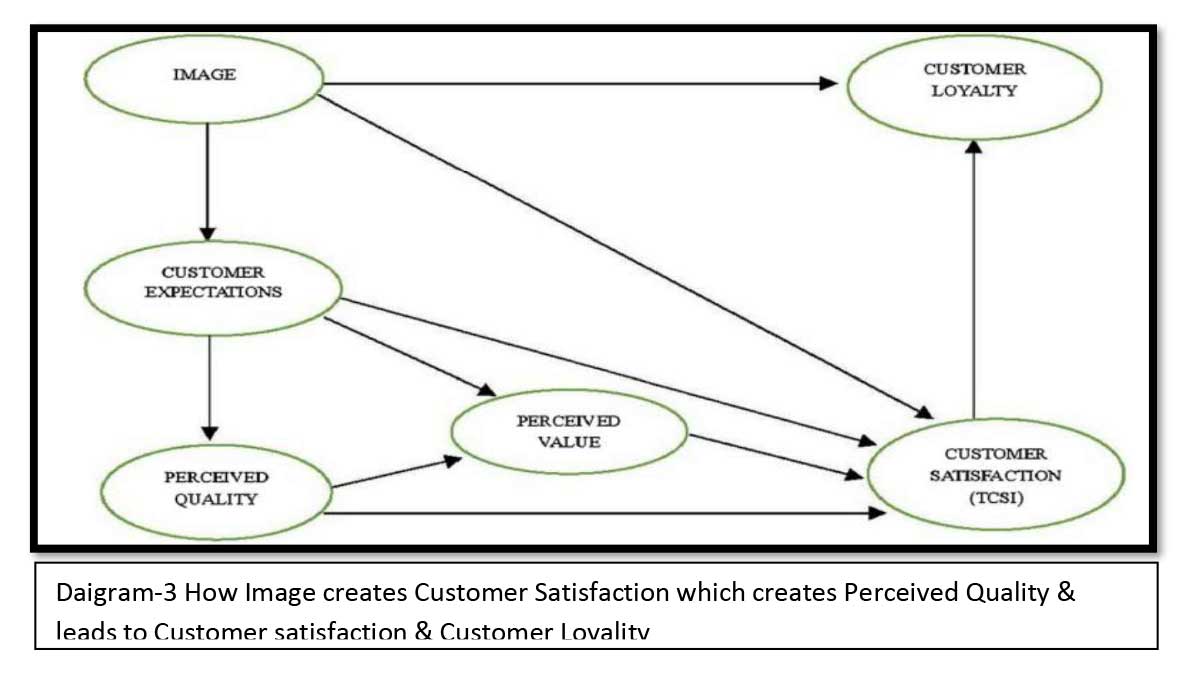
Kano Model For Customer Satisfaction-The Kano Model of Customer Satisfaction classifies product attributes based on how they are perceived by customers and their effect on customer satisfaction. These classifications are useful for guiding design decisions in that they indicate when good is good enough, and when more is better. The Kano Model is also known as "Kano Analysis" was created by Japan’s Dr. Noriaki Kano in 1984 and to this day it remains to be a useful tool in Product and Service Development. The model brings out the nonlinear relationship between the product performance and customer satisfaction. The model divides product attributes into four categories: threshold, performance, excitement and indifferent (Figure 1).
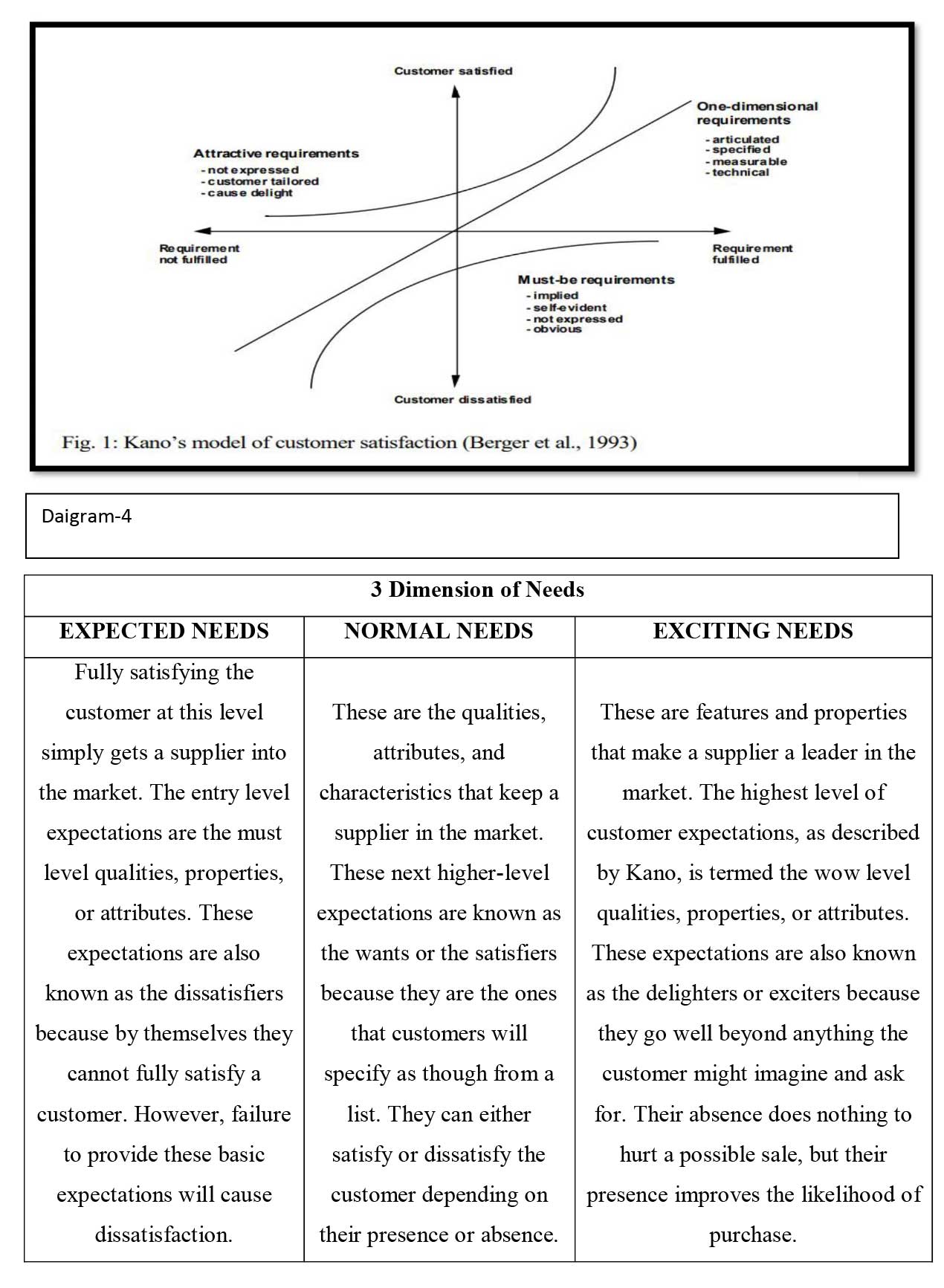
Wows not only excite customers to make on-the-spot purchases but make them return for future purchases. These are unspoken ways of delighting the customer. Examples include heads-up display in a front windshield, forward- and rear-facing radars, and a 100,000 mile warranty. Over time, as demonstrated by the arrow going from top left to bottom right in the Kano model, wows become wants become musts. For example, automobile self-starters and automatic transmissions. The organization that gets ahead and stays ahead constantly pulses its customers to identify the next wows. The best wows, plenty of wants, and all the musts are what it takes to become and remain an
Limitation- In kano Model how the Expected need , Normal Need & Exciting Need are influenced by the internal cognitive variables ie, Cultural upbringings, Attitude & behaviour etc. not explored.
Onlineconsumerbehaviour:Theoreticalbackground-Consumer behaviour is "how consumers think and behave when making purchase decisions." Itis defined as 'the study of understanding how the consumer makes decision about spending his/her limited resources, such as time, effort and money for purchasing. This definitionis also applicable in online consumer behaviour except the use of technology in purchase decision. A consumer decision largely influenced by his/her personal, social, psychological and cultural factors as shown in Exhibit no.1

Onlineconsumerbehaviour:Theoreticalbackground-Consumer behaviour is "how consumers think and behave when making purchase decisions." Itis defined as 'the study of understanding how the consumer makes decision about spending his/her limited resources, such as time, effort and money for purchasing. This definitionis also applicable in online consumer behaviour except the use of technology in purchase decision. A consumer decision largely influenced by his/her personal, social, psychological and cultural factors as shown in Exhibit no.1
Literature Review on Consumer Theory/Models-
Let’s refer to the below Table to understand the comparison between existing Theories.

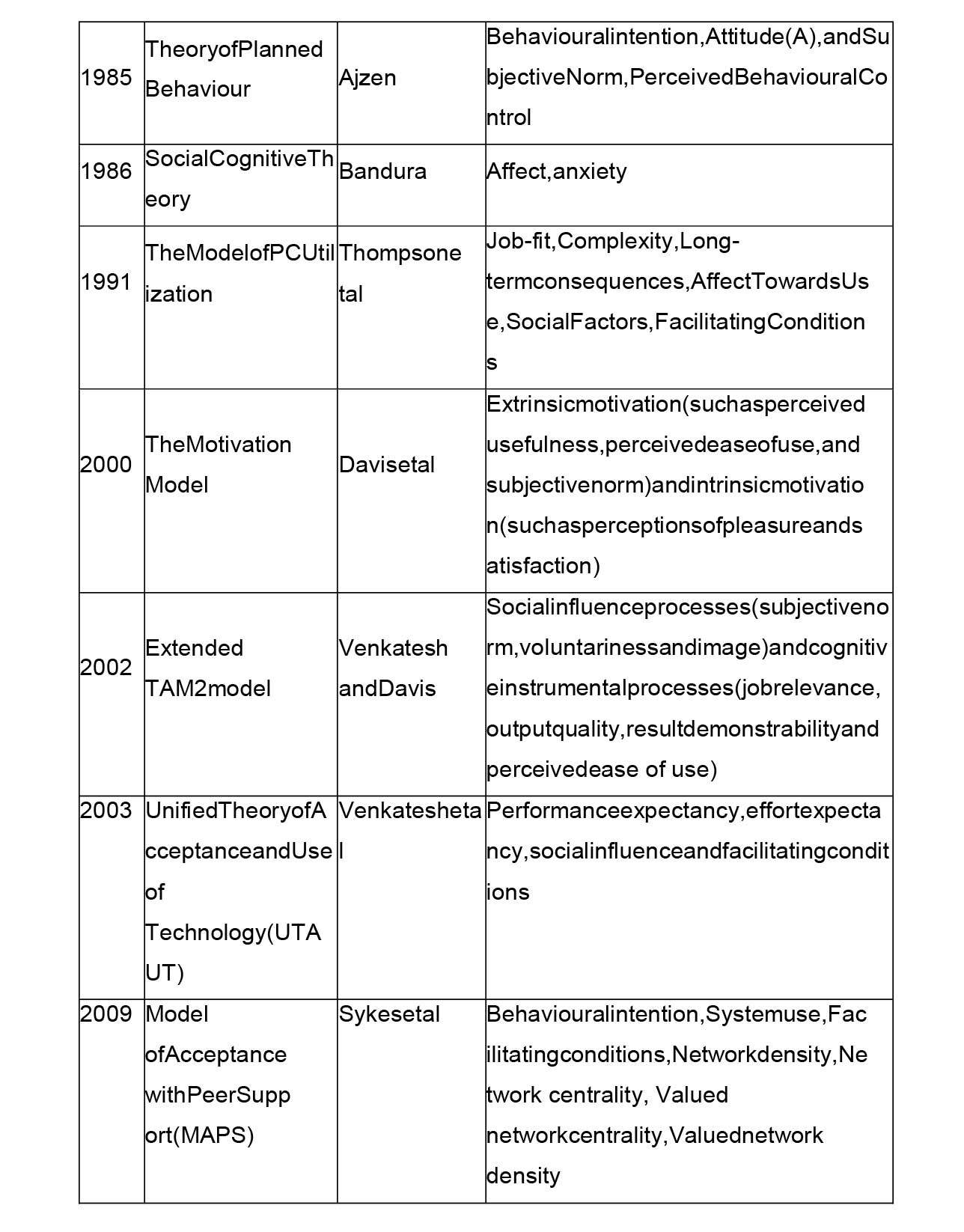
Discussion –
In all the above theories it has been discussed how Trust is manipulated through various External & Internal influencing variables. How Customer Satisfaction level is driving Customer behaviour & ultimately repurchase is not clearly understood from the stated theories.
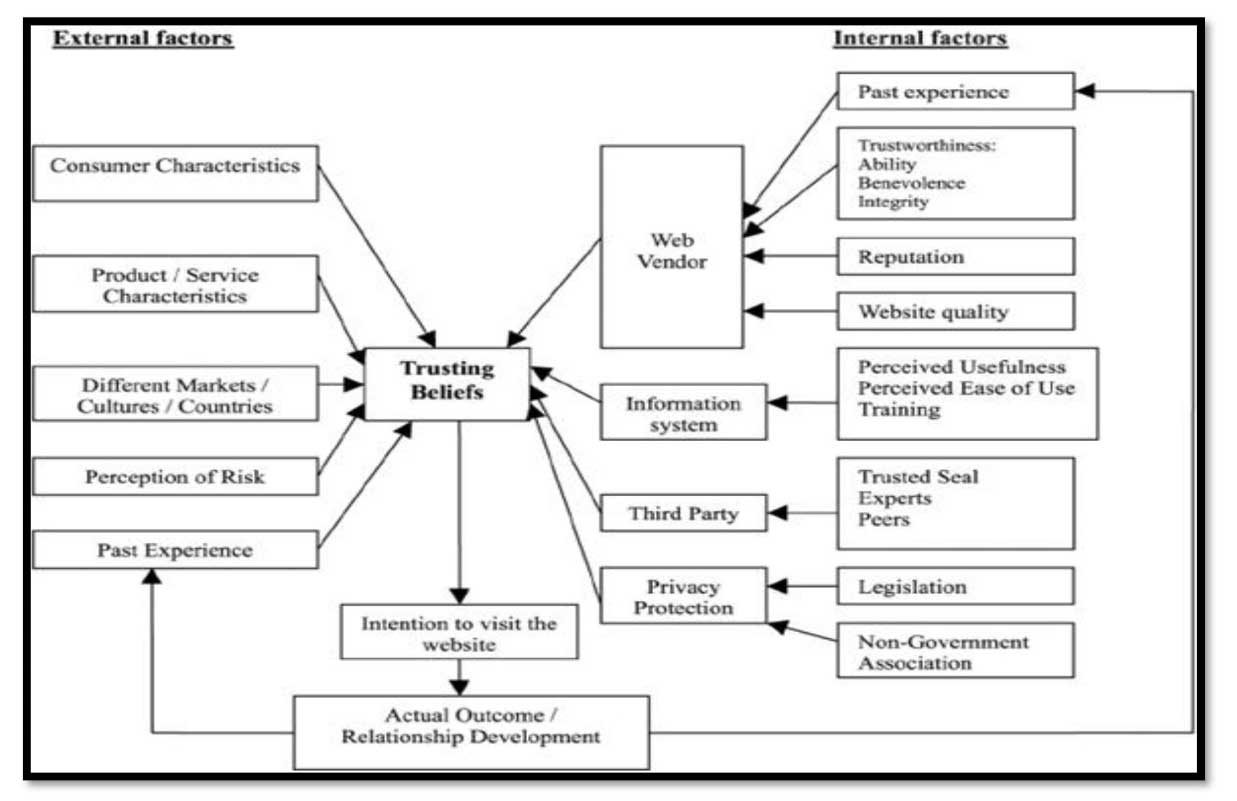
Black Box Model of Consumer Behaviour-
The model (or framework) of consumer behavior was first devised by Professor Geoffrey Jones and his colleague at the Center for Marketing Studies, Cambridge University. It has been elaborated on further by Australian academics such as Rodney Hitchin.
They suggested that often consumers are not sure about what influences their buying decision process. The answers to those questions are often buried within the customer’s mind. The model consists of three major components namely: Environment, Buyer’s black box, and Buyer’s responses.

Buyer’s black box
The buying decision is made by a person that does not fully understand all factors influencing him or her. This refers to the customer interacting between past experience, beliefs, desires, and objectives when making a buying decision. The buyer’s "black box" consists of his/her personal preferences and attitudes towards the product-market fit as well as the value creation process itself.
Buyer’s Characteristics
The buyer’s characteristics work closely with the buyer’s black box. A buyer’s character depends on many factors such as information and motivation. It is believed that buying characters are relatively stable over time while people can change attitudes of their personal preference during a lifetime for an item which has influenced them in the early years. The buying characters are determined by other people’s information, purchase behaviour, and brand attitudes.
Buyer’s Decision Process
The buyer’s decision process is the sequence of steps that the buyer will follow when making a buying decision. It can be broken down into five phases: Concept selection, Search, Evaluation, and Selection (SEES), Evaluative experience, Calculating purchase motives,and Adaptation to new feelings for this item over time. The mentality, needs, and expectations of the buyers are important to take into account when making a purchase but hard data may not always show influence on pricing decisions since there can be no direct association between quality perceptions and these actual buying motives.
Buyer’s responses
After purchase, the product performance can also affect the reaction of buyers. If a person who is angry or upset with an experience suffers from buyer’s remorse, s/he may be inclined to purchase to revise the past event in order for this negative feeling to be removed although it seldom happens because many people are purchasing a product without first having any thoughts to it.
Conclusion- Black Box Model defines How, Why When & What people buy but it fails to describe the Repurchase behaviour of Customer.
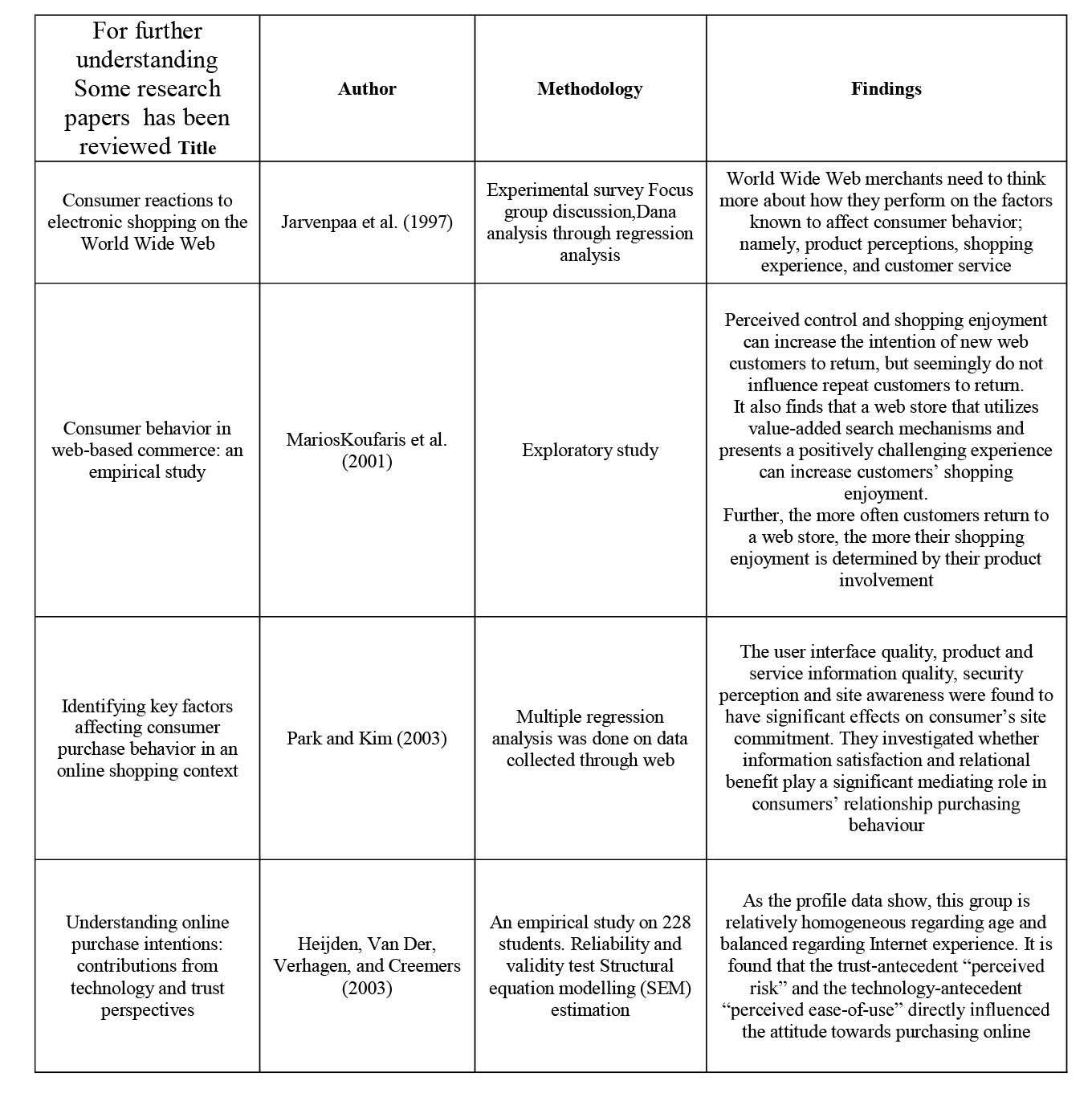
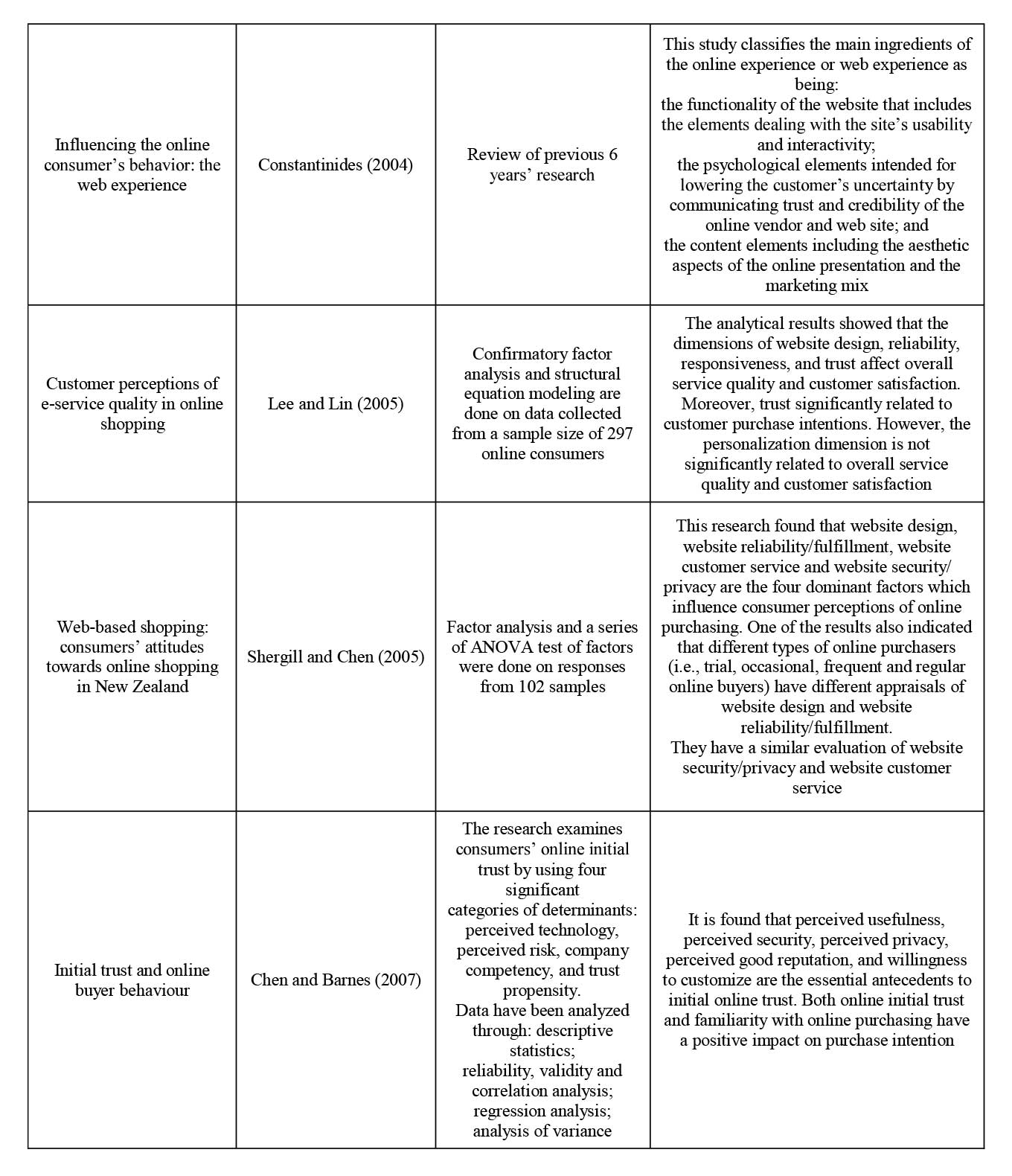
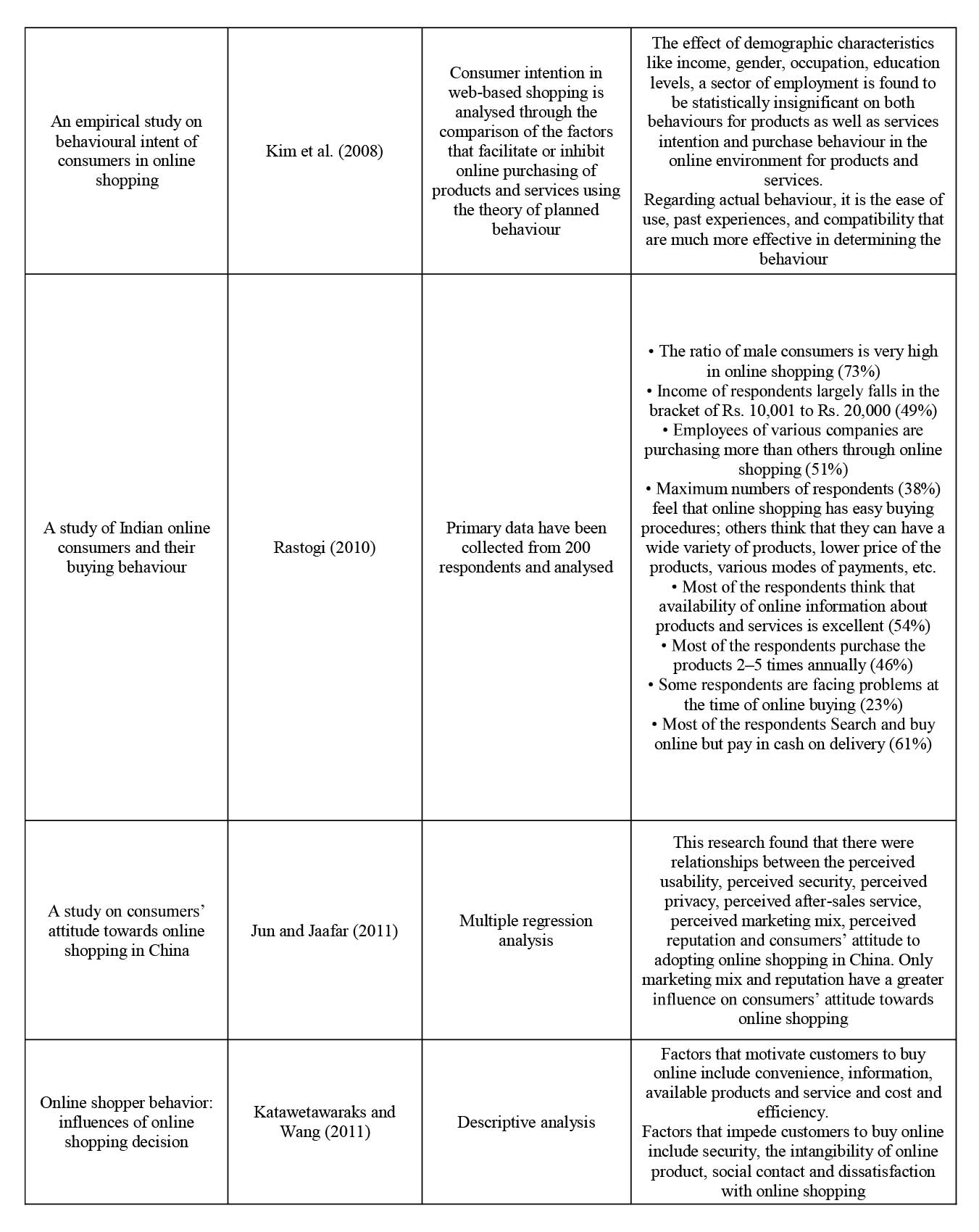


Conclusion-After close examination of the above papers it is found that how Customer Satisfaction, Attitude ,Trust ,Belief , Socio Cultural environment is driving Customer Buying behaviour study can be further done on how Word of Mouth is directly build Trust while we buy online & if it is the most important influencing factor while purchase high value items in online.
Proposed Model for Study-
Proposed model have been devised which is not limited but willl establish the strength in relationship in context of buying Large Appliances from Online.
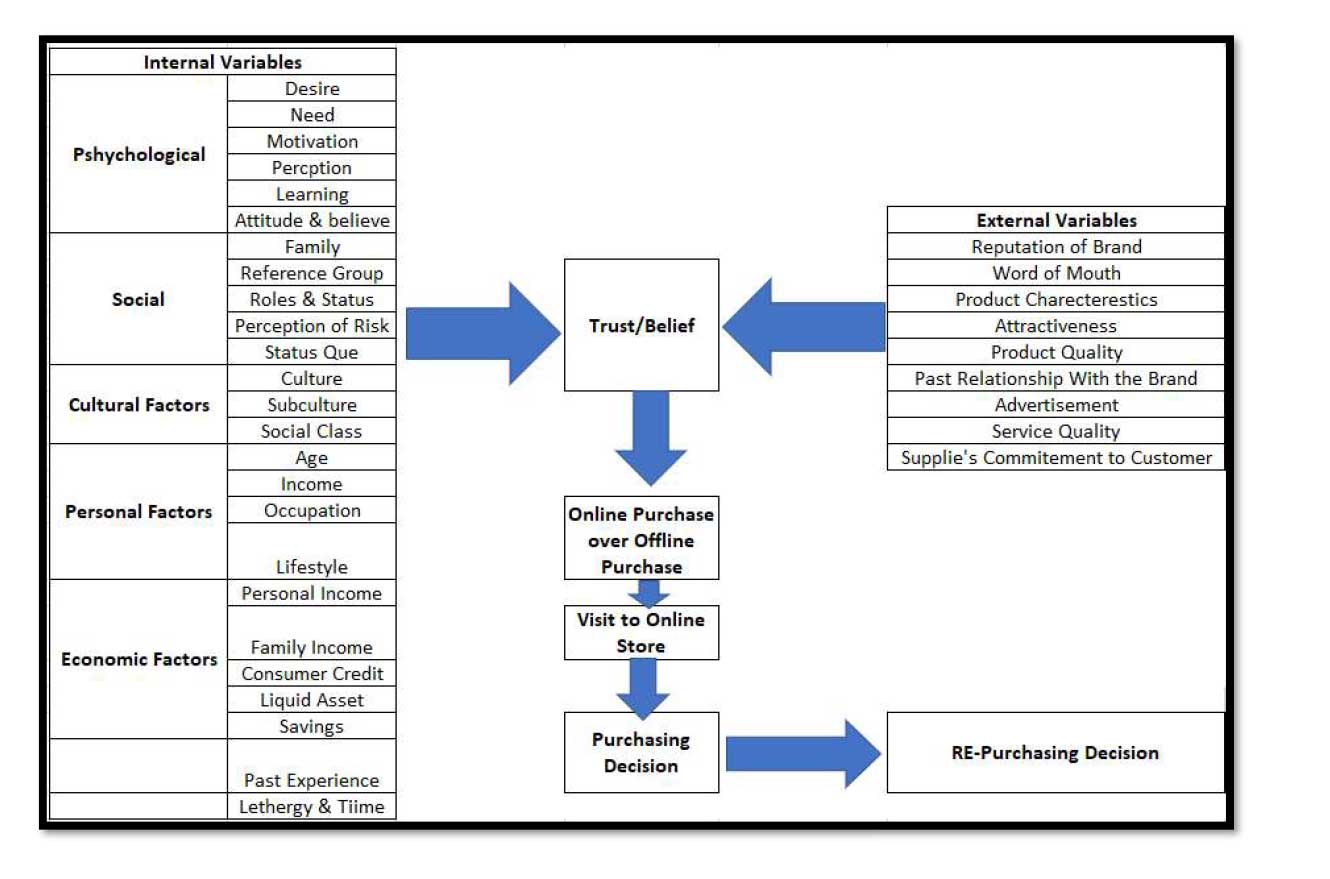
The above model will try to analyse the most influential variable changing consumer perception and push for online purchase the shift of Consumer behaviour is also deterministic in the Study.
References
- A study on factors limiting onlineshopping behaviour of consumers BindiaDaroch, Gitika Nagrath and Ashutosh Gupta ,Department of Commerce and Business Management,DAV University, Jalandhar, India.
- An empirical research on customer satisfaction study: a consideration of different levels of performance,Yu‑Cheng Lee1, Yu‑Che Wang2, Shu‑Chiung Lu3,4, Yi‑Fang Hsieh6, Chih‑Hung Chien3,5, Sang‑Bing Tsai7,8,9,10,11,12*and Weiwei Dong
- An Examination of Factors Influencing Repurchase Intention Towards a Fashion Brand in Thailand ,WeerinSuzuki,SirionChaipoopirutana, Howard Combs,
- Consumer Satisfaction Theories: A Critical Review, AtilaYüksel&FisunYüksel, Adnan Menderes University,Consumer buying behavior towards online shopping: An empirical study on Dhaka city,Bangladesh,MohammadAnisur Rahman, Md. Aminul Islam, Bushra Humyra Esha,
- Nahida Sultana & Sujan Chakravorty
- Online Consumer Behaviour Models:A Literature Review Dr Sunanya Khurana, Ms BaljinderKaur,The Impact of Consumer Purchase Behavior Changes on the Business Model Design of Consumer Services Companies Over the Course of COVID-19,Hu Tao1, Xin Sun1*, Xia Liu1, Jinfang Tian2 and Di Zhang
- A STUDY OF ONLINE PURCHASE BEHAVIOUR OF CUSTOMERS IN INDIA ,pasana Kanchan, Naveen Kumar and Abhishek Gupta,School of Management, Gautam Buddha University, India
- A STUDY ON CONSUMER BEHAVIOUR TOWARDS ONLINE SHOPPING SANTHOSH V.r. BASAVARAJAPPA B.
- Review on "Expectancy Disconfirmation Theory" (EDT) Model in B2C E-Commerce Naeimeh Elkhani1, Aryati Bakri.
- THE KANO MODEL: HOW TO DELIGHT YOUR CUSTOMERS, ElmarSauerwein , Franz Bailom, Kurt Matzler, Hans H. Hinterhuber*,Department of Management, University of Innsbruck
- The quality of word-of-mouth in the online shopping mall HyeKyoung Kim and Jihoon Song Oklahoma State University, Stillwater, Oklahoma, USA
